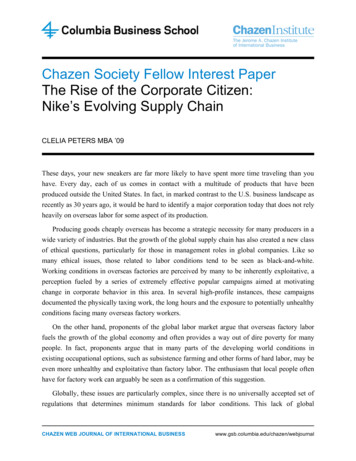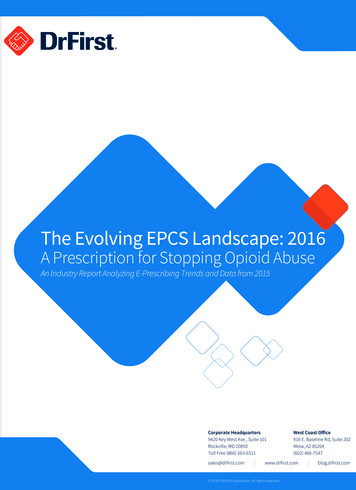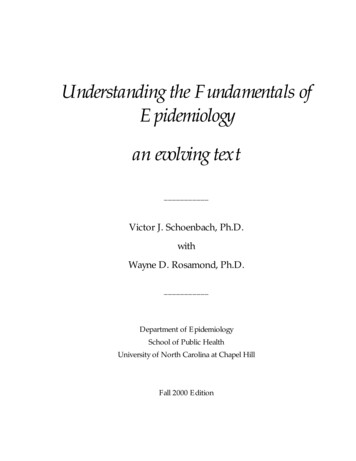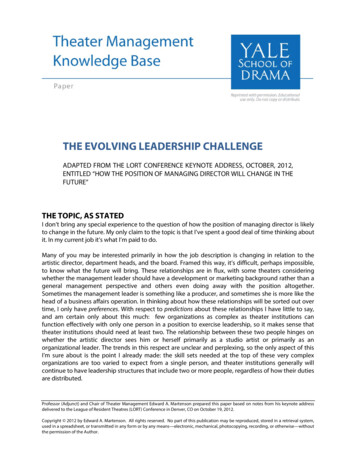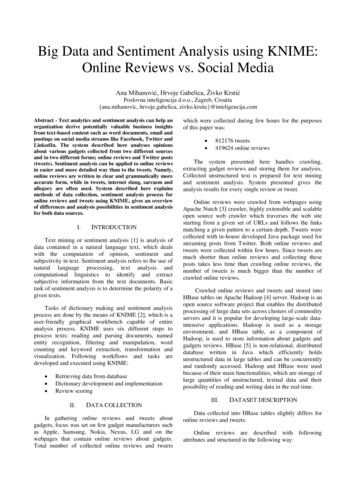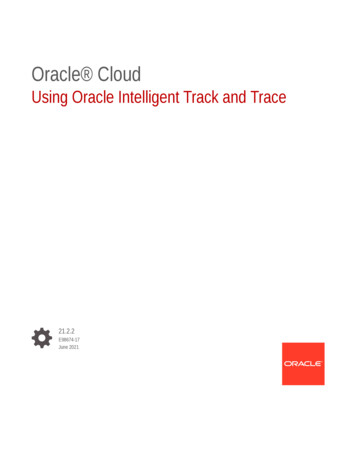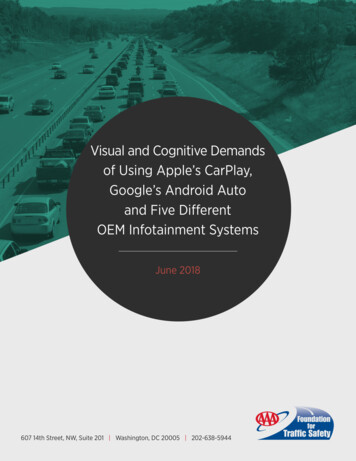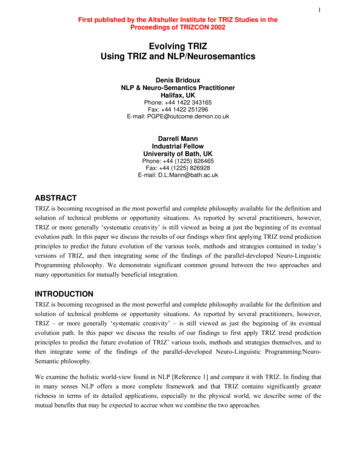
Transcription
1First published by the Altshuller Institute for TRIZ Studies in theProceedings of TRIZCON 2002Evolving TRIZUsing TRIZ and NLP/NeurosemanticsDenis BridouxNLP & Neuro-Semantics PractitionerHalifax, UKPhone: 44 1422 343165Fax: 44 1422 251296E-mail: PGPE@outcome.demon.co.ukDarrell MannIndustrial FellowUniversity of Bath, UKPhone: 44 (1225) 826465Fax: 44 (1225) 826928E-mail: D.L.Mann@bath.ac.ukABSTRACTTRIZ is becoming recognised as the most powerful and complete philosophy available for the definition andsolution of technical problems or opportunity situations. As reported by several practitioners, however,TRIZ or more generally ‘systematic creativity’ is still viewed as being at just the beginning of its eventualevolution path. In this paper we discuss the results of our findings when first applying TRIZ trend predictionprinciples to predict the future evolution of the various tools, methods and strategies contained in today’sversions of TRIZ, and then integrating some of the findings of the parallel-developed Neuro-LinguisticProgramming philosophy. We demonstrate significant common ground between the two approaches andmany opportunities for mutually beneficial integration.INTRODUCTIONTRIZ is becoming recognised as the most powerful and complete philosophy available for the definition andsolution of technical problems or opportunity situations. As reported by several practitioners, however,TRIZ – or more generally ‘systematic creativity’ – is still viewed as just the beginning of its eventualevolution path. In this paper we discuss the results of our findings to first apply TRIZ trend predictionprinciples to predict the future evolution of TRIZ’ various tools, methods and strategies themselves, and tothen integrate some of the findings of the parallel-developed Neuro-Linguistic Programming/NeuroSemantic philosophy.We examine the holistic world-view found in NLP [Reference 1] and compare it with TRIZ. In finding thatin many senses NLP offers a more complete framework and that TRIZ contains significantly greaterrichness in terms of its detailed applications, especially to the physical world, we describe some of themutual benefits that may be expected to accrue when we combine the two approaches.
EVOLVING TRIZ COMBINING TRIZ & NLP/NEUROSEMANTICSAmong the areas of TRIZ we explore during our evolution prediction and NLP-integration discussion are:1) A re-examination of the TRIZ Inventive Principles in light of common approaches found in NLP andthe way our brains operate, and the emergence of new application heuristics associated with the waysystems evolve.2) An Examination of the benefits we might expect when we combine and integrate the way we applymultiple Inventive Principles to a given problem situation. In particular, we examine the 14 usefuleffects established in NLP research that are possible when we combine Principles and how they canhelp us to evolve stronger solution directions.3) Combination of the TRIZ system operator tool with the equivalent, and in many senses morecomprehensive model for viewing problem situation, found in NLP. We build on the initial workreported in this area [Reference 2] to identify further opportunities for enhanced performance of theTRIZ tool through integration with the NLP equivalent.The future of TRIZ has been the subject of significant discussion in recent times [3, 4]. Opinion differs as towhether it is still at the beginning or has reached the limits of its evolutionary potential. The conflict can beboth understood and resolved if TRIZ is recognised as a just a part (albeit a very important one) in a muchbigger system. For the sake of providing this bigger system with a label, we will propose the term‘systematic creativity’.TRIZ places great importance on the existence of evolutionary S-curves. In these terms, the differencebetween the s-curve for TRIZ (actually, bearing in mind the different TRIZ proponents and variations, sucha TRIZ s-curve should be seen as the averages of a cluster of subtly different s-curves) and an average curvethat might be constructed for ‘systematic creativity’ is illustrated in Figure 1. The conflict contained in thequestion ‘Is TRIZ a mature system or an immature one?’ is thus explained by a point marked on the figureillustrating the current evolutionary state. The point suggests that TRIZ is at the mature end of itsevolutionary potential (thus concurring with Vertkin’s comment [4] that ‘there hasn’t been a single newconcept introduced into TRIZ in the last 12 years’), but that TRIZ and the current position are still at therelative beginnings of the over-riding ‘systematic creativity’ curve. In terms of ‘systematic creativity’ it isevident that there have been many new concepts emerging in recent times.Although developed more recently than TRIZ, Neuro-Linguistic Programming/Neuro-Semantics – alsoshown as an s-curve in Figure 1 – has evolved from a very similar philosophical startpoint. Both TRIZ andNLP have been built on the idea of the studying and abstraction of excellence. In the case of TRIZ, theglobal scientific and patent databases provided the basis of method development; in the case of NLP it wascognitive science research into linguistics, psychology, cybernetics and anthropology, with specificadditional knowledge from psychotherapy – including Gestalt, Rogerian and Family Therapy andHypnotherapy. Both have sought to study ‘creativity’ from the perspective of modelling known successfulcreative personalities. They also have drawn from disciplines such as topology or technological models suchas lasers and holography, superconductivity and propulsion systems (among others) for useful metaphors ofthe way our mind works. While NLP can benefit from the tools TRIZ has developed to apply them to thehuman field, TRIZ, in turn, can make use of the tools NLP has developed to transpose them onto thematerial world. 2002 Denis Bridoux/Darrell Mannp.2
EVOLVING TRIZ COMBINING TRIZ & NLP/NEUROSEMANTICSFigure 1: Systematic Creativity, TRIZ and NLP/NS Evolutionary S-CurvesIdeality /C apabilitycu rren tp o sitio ncom posite‘system atic creativity’s-curveC om posite ‘T R IZ ’and ‘N LP ’ s-curvesT im eThe idea that TRIZ is one s-curve (system) inside a bigger system for now called ‘systematic creativity’emerges from the concept of recursiveness in systems. Recursiveness as discussed in the Viable SystemModel, NLP and other emerging texts on, not just creativity, but all system evolution is an example of aconcept which has not previously been well formed in classical TRIZ. The current prevailing view is thatrecursion will be an important element in the successful realisation of a ‘systematic creativity’ s-curve.The idea of TRIZ or NLP representing s-curves inside a higher order s-curve explains the s-curve figureconstructed by Savransky in reference [3], which suggests that the next stage of ‘TRIZ’ (but actually‘systematic creativity’) evolution is the integration of different methods.We suggest that the integration of TRIZ and NLP represents a significant step towards achieving a higherorder ‘systematic creativity’ system.AN OVERVIEW OF NEURO-LINGUISTIC PROGRAMMINGFor those involved in TRIZ who are unfamiliar with NLP, it began in the early 70s at Santa Cruz Universityas the brain-child of two people, Richard Bandler and John Grinder, who were interested in structure andlanguage: computer languages in the case of Richard Bandler, human languages in the case of John Grinder.Mentored by the anthropologist/cyberneticist Gregory Bateson, they drew to them many disciples interestedin the structure of excellence and creativity, the foremost of the day being Judith DeLozier (who becameGrinder’s wife), Leslie Cameron (who later became Bandler’s wife), Steve & Connirae Andreas and RobertDilts. These latter three did more than most to endow NLP with a strong methodology in the ‘70s and 80’s.In the 90’s, NLP trainer L. Michael Hall revisited the General Semantics model, developed by the Polishengineer Alfred Korzybski, which was an influence on NLP in its early days. Hall recursively applied it toNLP. The first recursion brought out the Meta-States model. The second recursion, carried out on thesuggestion of one of the authors (Denis Bridoux) led to the emergence of the wider Neuro-Semantics model(NS), which incorporates and encompasses NLP and adds to it an understanding of, and an ability to trackand work with, all the upper levels of mind. In its way Neuro-Semantics further develops the initial NLP Scurve and much of the theoretical and practical innovation in the field currently occurs in Neuro-Semantics,including some presented herewith for the first time. By incorporating recursive visits of Gregory Bateson’sapproaches, the NS model is also expanding into the modelling of Culture. 2002 Denis Bridoux/Darrell Mannp.3
EVOLVING TRIZ COMBINING TRIZ & NLP/NEUROSEMANTICSBoth TRIZ and NLP/NS have two mains fields of application [Figure 2]:1. Problem-Solving (Remedial work)2. Innovation, Improvement, Enhancement, and possibly Replacement of an existing product(Generative Work).Figure 2: Fields of ApplicationRemedialWorkGenerativeWorkIdeally any resolution of a problem will not just do that, but also offer significant additional improvementand enhancement and contribute to the ideality of other structures above and beyond that directly worked on:it will improve the ideality of the whole system.A more complete overview of NLP/NS and its operational structure is provided in the Appendix at the backof the paper.AN OVERVIEW COMPARISON BETWEEN TRIZ AND NLP/NSAs already stated, TRIZ and NLP/NS both feature a hierarchy of tools, strategies/methods and philosophies.It is useful to compare the two at each of these levels in order to highlight the similarities and (hopefullybeneficial) differences. The following table offers a summary of this comparison at the philosophical,methodological and tool levels. 2002 Denis Bridoux/Darrell Mannp.4
EVOLVING TRIZ COMBINING TRIZ & NLP/NEUROSEMANTICSHierarchical LevelPhilosophical OverallPhilosophical DetailTRIZDistillation ofscientific excellence(4 1) pillars:FUNCTIONALITYRESOURCESIDEALITYAWARENESS OF CONTRADICTIONSThinking in terms of space/timeMethods, Models& StrategiesARIZ(various versions)Many ‘problem solving’processes from differentTRIZ providersInnovation patterns(enhancing and improvingan existing product)Tools for Mapping(This categoryand the one belowoverlap,so patterns whichappear in one will notbe repeatedin the other)Toolsfor InterventionNLP/NEURO-SEMANTICSDistillation of excellence from all fields ofendeavour, including TRIZ“4 Pillars”:RAPPORTACUITY OF PERCEPTIONOUTCOME ORIENTATIONFLEXIBILITY OF BEHAVIOURPhilosophical, Structuraland Operational PresuppositionsPositive IntentionRecursion / IterationPragmatic PerspectiveExistence of ResourcesOptimisationResolution of ContradictionsPrinciple of Least EffortThinking in terms of atesMind-Lines model of communicationTOTE ModelRequisite VarietyCombinations of ToolsMany Solution-Oriented ProcessesRemedial work (problem-solving)Generative work (enhancing andimproving something that already works)Function/Attribute AnalysisS-Curve AnalysisS-Field AnalysisSubversion AnalysisIdeal Final Result/’Self’Resource AnalysisContradiction Matrix‘Chunking’ Patterns‘Nesting’ PatternsRepresentational SystemsSubmodalitiesElicitation of ResourcesConsequences/ EcologyPsychological Inertia ToolsInventive PrinciplesSeparation PrinciplesInventive StandardsTrends of EvolutionKnowledge/EffectsPsychological Inertia ToolsPattern interruptsReframing Patterns‘Change of Perceptual Perspectivesin Space, Time & Relationships’Installation of ResourcesAnchoringAs can be seen below, TRIZ and NLP are also similar in other aspects: 2002 Denis Bridoux/Darrell Mannp.5
EVOLVING TRIZ COMBINING TRIZ & NLP/NEUROSEMANTICSTRIZHierarchy of FunctionsNLP / NEURO-SEMANTICSChunkingStates/Meta-StatesLogical Levels/ Subjective HierarchiesIdeality(Absolute)Desired StatesOptimisation Patterns(Relative/ to context / situation / circumstance)An asymptotic curve where the law of diminishing returns appliesSTRIVING TOWARDS IDEALITYThe Most that can be achieved with the LeastResolution of ContradictionsResolution of Contradictionswhen well-formed outcomes are achievedLevels of InnovationLevels of LearningZero Learning: No learning achieved1st Level: Proto-Learning: Learning by Anchoring/Associating A with Bnd2 Level: Deutero-Learning: Learning to Learn3rd Level: Trito-Learning: Learning About How to Speed up Learning4th: Level:Tetro-Learning: Learning About Schools of AcceleratedLearningetc.Levels of IntentionalityParameters of a materialDynamizationSubmodalitiesProgress towards OptimalAdaptation to Adaptation, etc.Adaptation to Changing EnvironmentAdaptation to ingS-Field modellingStrategies and modelling processes at a structural level(see Appendix C: Table of Structural Operations Carried Out in Human Changework) 2002 Denis Bridoux/Darrell Mannp.6
EVOLVING TRIZ COMBINING TRIZ & NLP/NEUROSEMANTICSAt the method level, the following table compares a typical ARIZ scheme with similar models applied inNLP.ARIZAnalysis of ProblemElicitation of ContradictionsAnalysis of theproblem’s modelFormulation of theIdeal Final ResultUtilisation of outside substancesand Field ResourcesUtilisation ofInformational data bankChange orreformulatethe problemAnalysis of the methodthat removed the contradictionUtilisation ofFound SolutionsAnalysis of Stepsthat Led to the SolutionNLPElicitation of Problem: Present StateAnalysis of problemMeta-modelAnalysis of the problem’s structureand review possible processes that might apply for thisFormulation of the Desired StateWell-Formed OutcomesElicitation of Resources,both within conscious awareness and unconscious onesUtilisation of higher frames of mind to give structure,ratify and optimise application of resourcesI
In the 90’s, NLP trainer L. Michael Hall revisited the General Semantics model, developed by the Polish engineer Alfred Korzybski, which was an influence on NLP in its early days. Hall recursively applied it to NLP. The first recursion brought out the Meta-States model. The second recursion, carried out on the suggestion of one of the authors (Denis Bridoux) led to the emergence of the wider .

